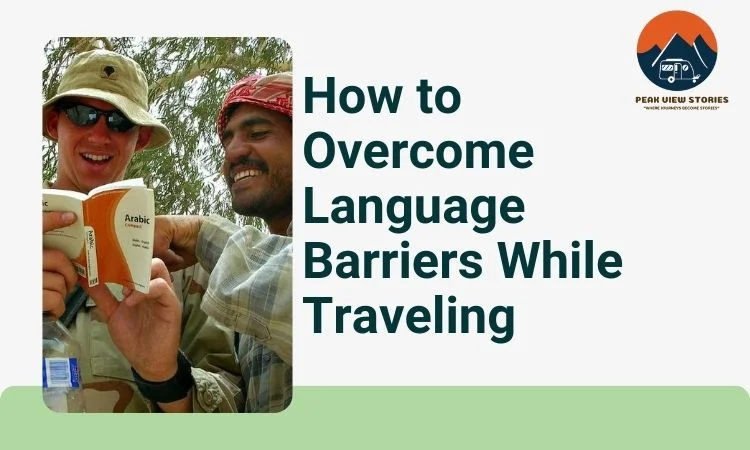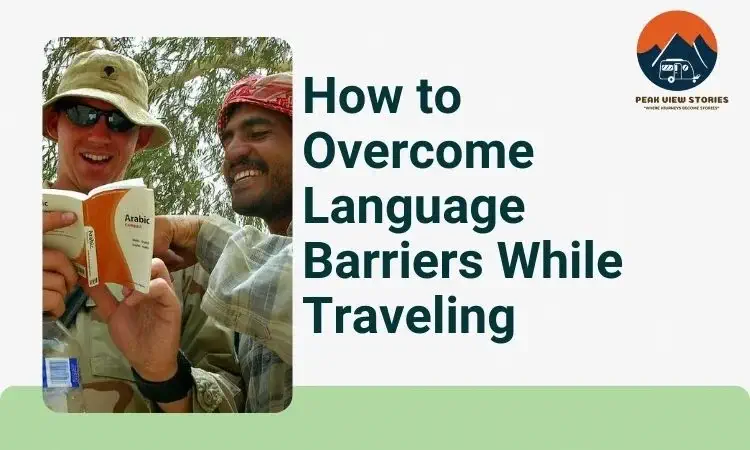Remember that time in Rome when you desperately needed to find a bathroom, but “bagno” was the only Italian word you could recall? You fumbled through your phone’s translation app, pointed frantically at various shop signs, and finally, with a sigh of relief, stumbled upon the little restroom icon. While the experience might have been a tad stressful, it also became a hilarious story to tell back home.

Let’s face it, language barriers are a fact of life for adventurous and business travelers. But fear not, explorers! This guide will equip you with the tools and strategies to navigate these challenges to overcome language barrier while traveling and forge connections that transcend words, transforming what could be frustrating roadblocks into unforgettable travel anecdotes.
How to Overcome Language Barrier While Traveling
Tech Tools to the Rescue: Your Digital Language Lifeline
Before you even board the plane, make friends with a reliable translation app. Google Translate and Microsoft Translator are popular options, offering real-time translation of spoken words, phrases, and even menus through your phone’s camera. Downloading essential phrases for offline access is a lifesaver in areas with spotty internet.
Pro Tip: Practice using the app’s voice recognition feature beforehand – the clearer your pronunciation, the more accurate the translation.
Now, translation apps are fantastic, but they’re not perfect. Think of them as helpful assistants, not magic wands. Sometimes, humorously nonsensical translations can occur.
Remember the time I tried to order a “fried friend” in a Thai restaurant using my app? Let’s just say, the waiter’s confused expression was priceless. This is where the magic of human interaction and a few other tricks come into play.
Beyond Words: The Power of Nonverbal Communication
Humans are wired for communication, and guess what? A significant portion of it happens without uttering a word! A warm smile, a raised eyebrow, a thumbs-up – these universal gestures can bridge language gaps and build rapport. When you’re struggling to articulate something, use animated facial expressions and body language to add emphasis. Nodding your head shows understanding, pointing clarifies your needs, and a genuine smile speaks volumes in any dialect.
Remember, cultural nuances exist. A thumbs-up might be a sign of approval in North America, but it carries a different meaning in some parts of the Middle East and West Africa. Do a little research on common nonverbal cues in your destination country to avoid any unintentional faux pas.
Learn a Few Key Phrases: It Goes a Long Way
Investing a little time in learning a handful of essential phrases in the local language goes a long way. Resources like Duolingo and Memrise offer bite-sized lessons perfect for busy travelers. Focus on greetings like “Hello” and “Thank you,” basic questions like “Where is the bathroom?” and “How much does this cost?”, and simple statements like “Please” and “Excuse me.” Even these basic phrases demonstrate respect for the local language and culture, and trust me, locals will appreciate the effort.
I still remember my first solo trip to Japan. My entire Japanese vocabulary consisted of “konnichiwa” (hello) and “arigato gozaimashita” (thank you very much). While conversations were limited, those few phrases opened doors (literally and metaphorically) and created positive interactions with shopkeepers and fellow travelers. Imagine the satisfaction of successfully navigating the bustling Tokyo subway system using just a few key phrases and gestures – a testament to the power of even basic language skills.
Embrace the Fun: Charades and Sketching Your Way Out
Sometimes, the best communication happens through a little playful creativity. Channel your inner child and embrace the art of charades! Need to find a taxi? Act out the motion of getting into a car. Lost and searching for your hotel? Mime the act of sleeping under a roof. Don’t be afraid to get a little silly – sometimes laughter is the best universal language.
Feeling particularly artistic? Whip out your notepad and unleash your inner Picasso. A quick sketch of a specific dish you’re craving or a landmark you’re searching for can work wonders in helping locals understand your request. This technique might even spark a conversation and lead to unexpected recommendations or friendly advice. Imagine the camaraderie that blossoms when you and a local shopkeeper attempt to decipher your artistic rendition of a steaming bowl of ramen – a shared moment of laughter and connection that transcends words.
Find a Fellow Traveler or Language Partner: Double the Fun, Double the Learning
Traveling with a friend who speaks the local language is a surefire way to overcome communication hurdles. They can translate menus, navigate public transportation, and help you decipher cultural nuances. But what if you’re flying solo? Don’t fret! The internet age has brought us language exchange apps like HelloTalk and Tandem. Connect with native speakers before your trip and practice basic conversation in exchange for teaching them a bit of your own language. This not only hones your language skills but also provides valuable cultural insights from a local perspective. Imagine the cultural richness gained from conversing with a local student over coffee, exchanging stories and insights that would otherwise remain hidden behind a language barrier.
Embrace the Journey: Unexpected Adventures and Laughter
Embrace these communication mishaps as opportunities for unexpected adventures and laughter. During a backpacking trip in Vietnam, I desperately needed to buy sunscreen. Armed with my trusty translation app and a determined spirit, I confidently marched into a pharmacy. After a series of confused exchanges (and a hilarious attempt at charades involving imaginary sunburn), the pharmacist emerged with a bottle of… hair conditioner.
We both burst into laughter, and with a little more creative communication (and some helpful hand gestures pointing at the Vietnamese word for “sun” on my phone), I finally walked away with the right product. This experience not only provided a hilarious story to tell, but it also underscored the importance of patience, a good sense of humor, and the universal language of laughter. Remember, sometimes the most memorable travel experiences arise from the unexpected detours and the shared laughter that bridges cultural divides.
Beyond Words: Building Connections Through Shared Experiences
While language is a powerful tool, communication transcends mere words. Here are some ways to connect with locals on a deeper level, even if you don’t share the same language:
Food is the Universal Language
Partake in a cooking class or visit a local market. The act of preparing and sharing a meal overcome language barriers and allows you to experience the heart of a culture. Imagine yourself learning to make traditional empanadas in a bustling Argentinian kitchen, the aroma of spices and laughter filling the air as you bond with your fellow classmates over a shared culinary adventure. These experiences create lasting memories and forge genuine connections that extend far beyond spoken words.
Embrace the Arts
Visit a museum, attend a local performance, or simply watch a street artist at work. Art speaks a universal language, and these experiences can provide a window into the local culture and spark meaningful connections.
Witnessing the intricate beauty of a Japanese tea ceremony, the captivating rhythm of a flamenco performance in Spain, or the raw emotion of a street artist’s mural – these cultural immersions offer a deeper understanding that transcends spoken words, fostering a sense of shared humanity that resonates across cultures.
Get Active
Join a yoga class, take a bike tour, or learn a traditional dance. Physical activity is another way to connect with people without relying on words. Imagine the exhilaration of a mountain bike ride through the Italian countryside, the shared effort and the breathtaking scenery forging a bond that transcends language. Or picture the camaraderie of a group yoga session on a Thai beach, the synchronized movements and peaceful atmosphere creating a sense of connection that transcends words.
Final Words: Overcome Language Barrier While Traveling, Embrace the Journey
To language barriers is an adventure in itself. By utilizing technology, embracing body language, and adopting a playful spirit, you can connect with people from all corners of the globe. Remember, the most important language is one of kindness and respect. So, pack your bags, embrace the unknown, and get ready to conquer the world, one conversation (or charade) at a time!
Bonus Tip: Embrace the Learning Process
Traveling with a limited understanding of the local language can be a fantastic learning experience. Carry a small notebook with you and jot down new words and phrases you encounter throughout your trip. Review them each evening and challenge yourself to use them the next day. This not only enhances your communication skills but also creates a personalized souvenir – a record of your language learning adventure.
Imagine the satisfaction of successfully ordering a meal in a foreign language using the vocabulary you’ve gathered on your travels. Remember, every new word learned is a step closer to unlocking a deeper understanding of the world around you.
Now go forth, intrepid traveler, and let the world be your classroom!
